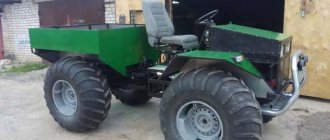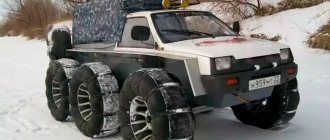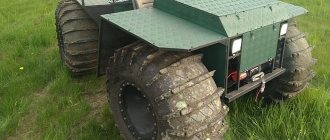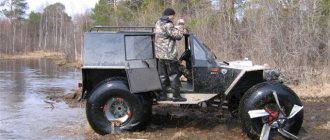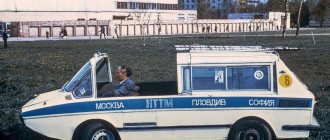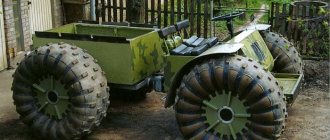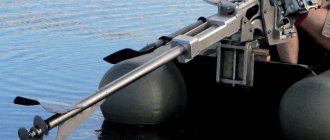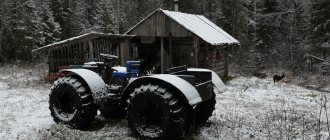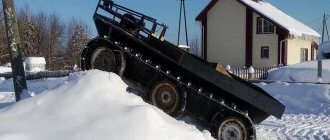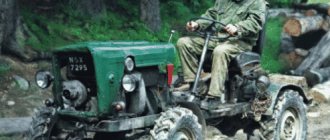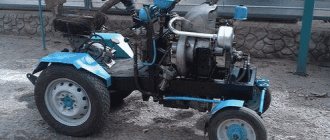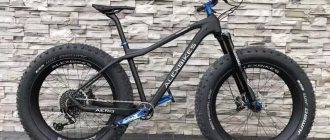DIY all-terrain vehicle from VAZ-2107
The guy converted his Zhiguli into a powerful all-terrain vehicle on low-pressure tires, we suggest you familiarize yourself with the homemade product in more detail.
The author had an idea to build a homemade all-terrain vehicle based on the VAZ-2107 for off-road travel.
The car body remained unchanged, only the suspension had to be modified to accommodate large low-pressure tires. The wheels on the all-terrain vehicle are “treads” made from used tires from KF 97 agricultural machinery. A new tread was cut out on the old tires, thus the weight of the tires was significantly reduced, and good treads increased the cross-country ability of the all-terrain vehicle.
The all-terrain vehicle has rear-wheel drive, but in addition, in addition to the standard gearbox, another Zhiguli gearbox was installed, which made it possible to reduce speed and increase traction. In the rear axle, the differential is welded. All parts and components were used only from Zhiguli.
The original VAZ engine, 1.5, remains unchanged; its power is more than enough for such an all-terrain vehicle.
Wheels converted from Zhiguli wheels.
The homemade all-terrain vehicle has excellent cross-country ability in mud, slush, and swampy terrain (it rides without straining); to drive on snow, you need to install skis on the front wheels. The all-terrain vehicle was not tested for buoyancy, but it should float on the water due to its large wheels.
We also recommend looking at another interesting homemade product - a tracked all-terrain vehicle based on the VAZ-2106
Features of the VAZ 2109 body
ATTENTION! A completely simple way to reduce fuel consumption has been found! Don't believe me? An auto mechanic with 15 years of experience also didn’t believe it until he tried it. And now he saves 35,000 rubles a year on gasoline! Read more"
“Nine” is a front-wheel drive passenger car with a hatchback body. The car is equipped with 5 doors. It has several modifications, released at different times and for different purposes - 21091, 21093, 21099.
The body of the “nine” is made in a load-bearing structure and is 1-volume. 5 people can easily fit inside the car, although the hatchback does not have the comfort of a sedan. It was with the aim of increasing the convenience and spaciousness of the interior that one of the modifications of the “nine” was invented - the VAZ 21099.
The body of the “nine” is distinguished by a wedge-shaped shape, which is already a plus. The fact is that this form can significantly improve the AED* characteristics and reduce the resistance of oncoming air flows when the vehicle is moving.
Significant benefits in reducing the impact of air flow come from the smoothed outer surfaces of the hood, the greater slope of the windshield and rear window, as well as the unusually smooth connection of the front bumper to the body frame.
This body layout, coupled with a more economical power unit and new tire shapes, made it possible to significantly reduce fuel consumption.
In addition, this indicator is closely related to the reduction in body weight, which was achieved through the introduction of lightweight plastics and new composite materials. The plastic parts of the body and interior of the Nine, and there are a lot of them in the car, weigh about 80 kg.
Note. The reduction in weight of the VAZ 2109 is also due to the use of lightweight aluminum materials.
To carry out tuning on the “nine”, it will be useful to know how much the body of the VAZ 2109 weighs. This will make it possible to strengthen the frame by adding as much extra weight as needed. According to the table below, we see that the weight of the VAZ 2109 body in its bare state is 450 kg. Designers call this mass useful.
Despite the light weight, the car owner is given the opportunity to easily transport from 50 to 275 kg of various cargo in the trunk, depending on the number of passengers inside the cabin.
Thanks to front-wheel drive and a special body structure, the “nine” is distinguished by enviable stability against lateral skidding. Good handling is ensured, again, due to the front drive wheels and the coincidence of the direction of the traction force with the direction of movement of the wheels.
The handling of the “nine” is especially good in comparison with other domestic cars, on icy roads, slippery roads, and so on.
In addition, the front-wheel drive design of the car allows for better use of the length of the body compared to rear-wheel drive models. This also makes it possible to reduce the weight of the car, make the interior and driving position more comfortable.
Due to the absence of intermediate transmission links in the “nine”, it is possible to increase the useful volume of the vehicle without increasing the dimensions of the body. In the “nine” the floor tunnel is short; only parts of the brake and exhaust system are located here.
The rear of the Nine is also very compact. The 20-litre fuel tank is located under the rear seat, and the spare tire is located in a niche in the floor of the luggage compartment. This helped increase the free space in the trunk.
Which is better - wheels or tracks?
Before building a homemade all-terrain vehicle, you need to decide on the type of chassis. The tracked design ensures uniform load distribution, which has a positive effect on the vehicle’s maneuverability. The disadvantage is the increased weight of the propulsion unit and difficulties with control, since turning requires the installation of side clutches and additional levers to control the clutches.
Wheeled vehicles are controlled by a standard mechanism that uses extended steering rods.
Wheeled all-terrain vehicles are equipped with low-pressure pneumatic tires borrowed from agricultural machinery. The suspension uses leaf springs that can support the weight of the structure. If you need to manufacture a maneuverable and lightweight all-terrain vehicle, it is recommended to use the “karakat” design. But in this case, it will not be possible to install a closed body from a passenger car.
Mini tractor drawing
As mentioned above, the drawing and diagram of the future unit is of great importance during manufacturing. After all, if you lose sight or memory of something, it will be very difficult to restore the entire structure. Be sure to consider the following nuances when starting to draw and calculate diagrams:
- the engine should be located in front of the driver's seat;
- the motor must be covered with a manufactured casing;
- a shortened frame will make the equipment compact and economical in fuel consumption;
- if you reduce the frame, do not forget about the displacement of the bridge;
- decide on the location of the fuel tank;
- remember that the front suspension needs to be strengthened;
- be sure to indicate changes to the chassis.
The project implementation consists of the following stages:
- Work on the kinetic scheme.
- We make the frame.
- We make the body.
- Installation of the engine and other systems.
- We fasten the steering.
Now let’s look at what specific parts will be needed for the job using the example of a VAZ engine model.
Step-by-step instructions for DIY assembly
Before starting assembly, drawings of the machine frame should be developed. The documentation indicates attachment points to the body and places for installing suspension spring brackets. On wheeled vehicles, the steering mechanism is mounted on the frame, and a cardan shaft is used to connect to the column. To build an all-terrain vehicle, you will need a channel and additional units from vehicles with an all-wheel drive system (for example, a transfer gearbox and drive axles).
All-terrain vehicle on wheels
A brief algorithm for building a wheeled all-terrain vehicle:
- Mark the steel profile, the elements are welded on the jig. The design provides points for mounting the transfer gearbox, outboard bearing supports, and spring mounts. At the top edge, brackets are welded to secure the body.
- Cover the frame with a primer and then paint to protect the metal from corrosion.
- Mount the leaf springs to which the axles are attached to the stepladders. If you plan to use an independent front suspension, then it is necessary to mount points for installing coil springs, shock absorbers and levers. In this case, drive is carried out only to the rear wheels.
- Install a transfer gearbox, which is connected to the main pairs in the axles using driveshafts modified in length.
- Modify wheel rims on which lightweight tires are installed (for example, “flat tires” based on tires from agricultural machinery).
- Install the car body onto the frame, ensuring the connection of the steering mechanism with the swivel wheels. Mount the driveshaft between the standard gearbox and the transfer gearbox.
- Attach additional guards to protect against dirt, and then check the operation of the all-terrain vehicle.
Strengthening and modernization
Strengthening or tuning the body of a VAZ 2109 according to the instructions should be carried out only if the owner is well versed in the design features of the car, has an appropriate understanding of the device, and knows the technical data on weight and other parameters. Otherwise, it is better to entrust the modernization work to professionals at the service station. True, the price of their services in these matters is too high, but you will be satisfied with the result.
So, tuning a VAZ 2109 car is, first of all, upgrading its body. The process always begins with this, and only after that the power unit and other components of the machine are brought to the desired state.
The need for reinforcement at “nine” and the quality of life indicator
It’s interesting that many owners of the “Nine” install modern amplification components more for the sake of beauty. This cannot in any way be a plus for reinforcement, since for the most part such elements can only provide decorative benefits.
On the contrary, if the goal of tuning is primarily to strengthen the body, TK*, spacers, rods and gussets can be selected accordingly. They will significantly strengthen the frame and increase its ability to withstand external influences.
TK* - tubular roll cage
Strengthening, as mentioned at the beginning of the article, is a mandatory procedure. By installing longitudinal and transverse reinforcing elements into the body structure, you can achieve a significant increase in the rigidity of the body frame, and this is already very good. The integrity of the original design obtained at the factory will be maintained and at the same time the corresponding torsional rigidity parameters will increase. At the same time, the weight of the car will practically not increase.
No matter how rigid the body is, it will have weak, vulnerable areas. Even if, under the influence of external forces, these places receive only microscopic damage, over time this will inevitably develop into a big problem.
You can verify the weakness of the “nine” body using a simple example:
- Raise the car on a jack (you can do it on one or both sides at once);
- In 80-90% of cases, car doors jam in the openings, which indicates deformation of the body.
Torsional rigidity or QR is one of the most important indicators of the condition of the body. Hatchbacks are much stronger than sedans in this regard. Thus, the strengthening of the body on the VAZ 21099 (sedan body type) should be carried out much more extensively in order to make it possible to increase the quality of life.
But, again, the VAZ 2109 body has a low quality of life indicator when compared with some foreign-made hatchbacks. This means that the car turns worse, with some delay, as design features interfere.
- During maneuvers and extreme driving, metal in the areas where the levers are attached causes mismatch in the operation of the suspension;
- Due to the periodic twisting that occurs during active driving, the body of the “nine” soon ages or, as engineers say, “gets tired.” This inevitably affects the destruction of welding seams and the appearance of intense corrosion.
Note. As mentioned above, hatchbacks, especially 3-door ones, performed better in terms of quality of life. Worse are sedans, station wagons and minivans.
Modern components for strengthening the body
Thanks to the technological breakthrough of recent years, designers are able to come up with various options for reinforcing elements.
Most often in modern body tuning, a strut is used on the front suspension. They put it on body “glasses”. The effect makes itself felt immediately as soon as the car picks up speed or the driver maneuvers in any other way.
The spacer, like most tuning components, came to the world of tuning from big sport. The body of a sports car was reinforced with such an element without fail, as rigidity increased, which had a positive effect on handling.
Homemade all-terrain vehicle from VAZ
A village craftsman built an original all-terrain vehicle for off-road forest travel, hunting, fishing, picking berries and mushrooms.
The all-terrain vehicle frame is made of channels, axles and a transfer case from an UAZ are installed. A VAZ body was installed on the frame along with the engine, gearbox and attachments.
The wheels are made from old GAZ-66 tires, with new treads cut out on the tires.
As a result of the alteration, ground clearance has increased significantly
The all-terrain vehicle moves well in deep snow.
Also, the all-terrain vehicle can move and stay on the water due to its large wheels. The photo shows how the all-terrain vehicle crosses the river.
As a result, the guy made such a real SUV from old Lada cars! The result was a very good all-terrain vehicle, although fuel consumption doubled.
Transmission
The wheels on homemade trucks are most often not original ones, so the standard gearbox sometimes cannot provide the required force. A way out of this situation may be to use a rigid box from GAZ (models 53 and 51) together with a low-power engine T-16, M-72, etc. In this case, the truck drawing usually includes an adapter made of a metal plate. The need for such a design arises due to the difference in size of the gearbox input shaft and the crankshaft of the power unit.
The easiest way to use mounted systems is to use homemade or hydraulic ones, and with this there is a need to include a power take-off in the transmission. The selection box can be shared by agricultural machinery or a recycled all-terrain vehicle. Completely remaking bridges is problematic, but by shortening the axle shafts and “stockings” you can change the dimensions of the base and the track size. Seats for axle shafts and bearings can be easily moved to another point in the frame, but this procedure must be accompanied by strengthening the welding site.
The designer's platform is a pure MAN KAT chassis.
Conqueror of the taiga
Life in the Siberian forests is so harsh that having your own SUV is not a luxury, but a real necessity; another thing is that not everyone can buy such a car.
The exception is local craftsmen who were able to put half of the VAZ-2106 body on tractor wheels, along with its engine and a cargo compartment attached to the rear, hastily welded from old metal sheets.
Other features of the pickup include reinforced suspension, the use of axles from an old UAZ, as well as benches for transporting passengers.
Another tanker from Yuzhnouralsk
A similar engineering feat was accomplished by a resident of Yuzhnouralsk, who placed his outdated Zhiguli on a large welded platform and tracks.
And in order to demonstrate the capabilities of the modernized VAZ, the self-taught mechanic asked his friends to shoot and publish an amateur video online, which clearly shows how easily the all-terrain vehicle overcomes the tests of snowdrifts and roadside slush.
What do I care about snow, what do I like heat, what do I like torrential rain?
Russian craftsmen designed the real beast, equipping the body of a VAZ-2107 with low-pressure wheels borrowed from the all-terrain KamAZ, and posted a video of its practical tests online. And judging by this video, the SUV will not only be immune to winter surprises, but also to floods, because it easily forded a shallow river.
At the same time, commentators doubted the efficiency of the Zhiguli engine, as well as the economy of such a solution, but they turned out to be right, because the developer himself indicated a consumption of 30-40 liters.
Snow blower from Zhiguli? Why not!
The next VAZ was put on a caterpillar track by an enthusiast from Barnaul, who decided to re-equip his old “seven” in this way.
However, unlike previous modifications, the author of this project decided to go even further by equipping the front part of the Zhiguli with a wide shovel, which made it possible to use the car for snow removal.
It is worth noting that this is not the first creation of the master, who has already created a tracked all-terrain vehicle with an electric motor, and not the last, because the creative Barnaul resident has plans for a swamp vehicle.
Little is known about this masterpiece, although its authors have opened a separate YouTube channel for their brainchild. So, given: a VAZ-2108 body, a welded rectangular frame, UAZ locking axles, as well as a gearbox and an 8-valve engine from a VAZ-2115, which replaced a less powerful manual transmission and an engine from OKI.
Solution: a fairly powerful swamp vehicle, the power units of which may not withstand truly serious and dangerous off-road conditions. But it looks impressive, yes.
Tools and materials
The main component of the vehicle is a durable waterproof body. You can make an all-terrain vehicle using profile steel pipes with the following sections:
Of course, the greater the load on an individual element, the larger the cross-section of the pipe used should be. The recommended thickness of sheet metal is at least 0.125 cm. It is not recommended to use very thick sheets, because they will significantly make the structure heavier and increase fuel consumption.
For a homemade all-terrain vehicle, you can use air-cooled motors. Their power can be 15-20 liters. s., and this is a very decent indicator, allowing you to move at high speed.
However, the largest tracked all-terrain vehicles are sometimes equipped with engines from the base vehicle, which will help move significant loads without losing momentum.
In a simpler version, gearboxes and axles are taken from the original car. As for the tools, you will predictably need:
welding machines (electric with suitable electrodes included, but gas can also be used);
wrenches and adjustable wrenches;
Universal all-terrain vehicle for village life
It all started with the fact that a family that moved to the village had to think about the future fate of their “six” after 20 years of its operation.
As a result, it was decided to put the VAZ body on the frame of a UAZ purchased for 9 thousand rubles, the owners of which were going to hand it over for disassembly. It is noteworthy that the latter’s units were also used, and they turned out to be in fairly good condition.
As a result, after tinkering a little with these two cars, the resourceful family acquired a universal SUV, using it for clearing snow, transporting firewood and plowing the garden.
